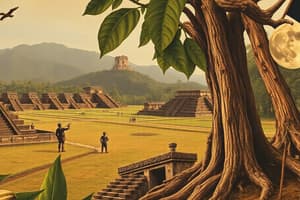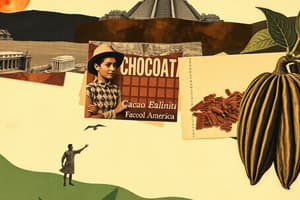Podcast
Questions and Answers
Chocolate originated over 3,000 years ago in ______ (present-day Mexico and Central America)
Chocolate originated over 3,000 years ago in ______ (present-day Mexico and Central America)
Mesoamerica
The ancient Mayans and Aztecs prized chocolate as a ______ item and used it as currency
The ancient Mayans and Aztecs prized chocolate as a ______ item and used it as currency
luxury
Chocolate is made from the beans of the ______ tree (Theobroma cacao)
Chocolate is made from the beans of the ______ tree (Theobroma cacao)
cacao
Cacao trees are grown in ______ regions near the equator
Cacao trees are grown in ______ regions near the equator
Chocolate became popular in ______ in the 18th century, particularly in England and France
Chocolate became popular in ______ in the 18th century, particularly in England and France
The ______ of the chocolate is mixed and aerated to develop the flavor and texture of the chocolate
The ______ of the chocolate is mixed and aerated to develop the flavor and texture of the chocolate
Dark chocolate contains ______, which have antioxidant properties
Dark chocolate contains ______, which have antioxidant properties
Couverture chocolate is high-quality chocolate with a high ______ content, used by professional chocolatiers
Couverture chocolate is high-quality chocolate with a high ______ content, used by professional chocolatiers
Verbs that do not follow the usual pattern of adding -ed to form the past simple and past participle are called ______ verbs
Verbs that do not follow the usual pattern of adding -ed to form the past simple and past participle are called ______ verbs
The past simple of the verb 'be' is ______ (singular) and ______ (plural)
The past simple of the verb 'be' is ______ (singular) and ______ (plural)
To improve grammar and vocabulary, practice using ______ verbs in sentences
To improve grammar and vocabulary, practice using ______ verbs in sentences
The past participle of the verb 'go' is ______
The past participle of the verb 'go' is ______
Make ______ to help memorize the past simple and past participle forms of irregular verbs
Make ______ to help memorize the past simple and past participle forms of irregular verbs
Focus on the most common ______ verbs first, and then move on to less common ones
Focus on the most common ______ verbs first, and then move on to less common ones
Flashcards are hidden until you start studying
Study Notes
History of Chocolate
- Chocolate originated over 3,000 years ago in Mesoamerica (present-day Mexico and Central America)
- The ancient Mayans and Aztecs prized chocolate as a luxury item and used it as currency
- Spanish conquistador Hernán Cortés introduced chocolate to Europe in the 16th century
- Chocolate became popular in Europe in the 18th century, particularly in England and France
Cacao Tree and Bean Production
- Chocolate is made from the beans of the cacao tree (Theobroma cacao)
- Cacao trees are grown in tropical regions near the equator
- It takes around 3-4 years for a cacao tree to mature and produce beans
- Each cacao pod contains 20-40 beans, which are harvested, fermented, and dried to develop their flavor and aroma
Chocolate Making Process
- Beans are roasted to bring out their flavor
- Shells are removed, leaving cacao nibs
- Nibs are ground into a paste called chocolate liquor
- Sugar, milk (if desired), and other ingredients are added to the liquor
- Conching: the mixture is mixed and aerated to develop the flavor and texture of the chocolate
- Tempering: the chocolate is cooled and reheated to create a smooth, glossy finish
Types of Chocolate
- Dark chocolate: made from cocoa solids, sugar, and sometimes milk powder
- Milk chocolate: made from cocoa solids, sugar, milk powder, and sometimes vanilla
- White chocolate: made from cocoa butter, sugar, and milk powder
- Couverture chocolate: high-quality chocolate with a high cocoa butter content, used by professional chocolatiers
Health Benefits of Chocolate
- Dark chocolate contains flavonoids, which have antioxidant properties
- Chocolate can improve heart health by lowering blood pressure and cholesterol levels
- Chocolate contains phenylethylamine, a natural mood elevator
- Chocolate can improve cognitive function and memory
History of Chocolate
- Chocolate originated in Mesoamerica (present-day Mexico and Central America) over 3,000 years ago
- Ancient Mayans and Aztecs valued chocolate as a luxury item and used it as currency
- Hernán Cortés introduced chocolate to Europe in the 16th century
- Chocolate became popular in Europe, particularly in England and France, in the 18th century
Cacao Tree and Bean Production
- Chocolate is made from the beans of the cacao tree (Theobroma cacao)
- Cacao trees are grown in tropical regions near the equator
- It takes around 3-4 years for a cacao tree to mature and produce beans
- Each cacao pod contains 20-40 beans, which are harvested, fermented, and dried to develop their flavor and aroma
Chocolate Making Process
- Roasting beans brings out their flavor
- Removing shells leaves cacao nibs
- Grinding nibs creates a paste called chocolate liquor
- Adding sugar, milk (if desired), and other ingredients to the liquor creates the chocolate base
- Conching develops the flavor and texture of the chocolate
- Tempering cools and reheats the chocolate to create a smooth, glossy finish
Types of Chocolate
- Dark chocolate consists of cocoa solids, sugar, and sometimes milk powder
- Milk chocolate combines cocoa solids, sugar, milk powder, and sometimes vanilla
- White chocolate is made from cocoa butter, sugar, and milk powder
- Couverture chocolate is high-quality chocolate with a high cocoa butter content, used by professional chocolatiers
Health Benefits of Chocolate
- Dark chocolate contains flavonoids, which have antioxidant properties
- Chocolate can lower blood pressure and cholesterol levels, improving heart health
- Phenylethylamine, a natural mood elevator, is present in chocolate
- Chocolate can improve cognitive function and memory
Irregular Verbs in the Past Simple
Definition and Characteristics
- Irregular verbs do not follow the usual pattern of adding -ed to form the past simple and past participle
- Their past simple and past participle forms must be memorized
Common Irregular Verbs in the Past Simple
be
- Past Simple: was (singular), were (plural)
- Past Participle: been
have
- Past Simple: had
- Past Participle: had
do
- Past Simple: did
- Past Participle: done
go
- Past Simple: went
- Past Participle: gone
take
- Past Simple: took
- Past Participle: taken
make
- Past Simple: made
- Past Participle: made
know
- Past Simple: knew
- Past Participle: known
think
- Past Simple: thought
- Past Participle: thought
see
- Past Simple: saw
- Past Participle: seen
hear
- Past Simple: heard
- Past Participle: heard
say
- Past Simple: said
- Past Participle: said
get
- Past Simple: got
- Past Participle: got
lose
- Past Simple: lost
- Past Participle: lost
choose
- Past Simple: chose
- Past Participle: chosen
Tips for Learning Irregular Verbs
- Create flashcards to help memorize the past simple and past participle forms of irregular verbs
- Practice using irregular verbs in sentences to improve grammar and vocabulary
- Focus on the most common irregular verbs first, and then move on to less common ones
Studying That Suits You
Use AI to generate personalized quizzes and flashcards to suit your learning preferences.




